|
|
White House Office of Science and Technology Policy officials visit Fermilab
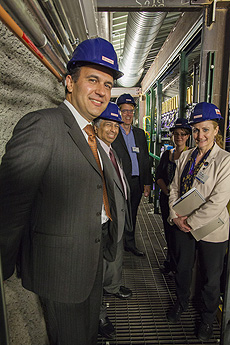 |
Officials from the White House Office of Science and Technology Policy tour the Minos underground area. From left: Saul Gonzalez, OSTP assistant director, Physical Sciences; Tof Carim, OSTP assistant director, Research Infrastructure; Joe Lykken, Fermilab deputy director; Louise Suter, Argonne National Laboratory; Jo Handelsman, OSTP associate director for Science. Photo: Cindy Arnold |
On Thursday, members of the White House Office of Science and Technology Policy visited Fermilab. On their tour, they visited ROC East and ROC West, the FAST Facility, the Cryomodule Test Facility and the Minos underground area.
|
Latin American consuls general visit Fermilab
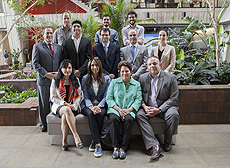 |
Several consuls general representing Latin American countries in Chicago visited Fermilab last week. Front row, from left: Marcela Carena (Fermilab, University of Chicago); Giselle Castillo-Veremis (Dominican Republic); Patricia Maza-Pittsford (El Salvador); Jesús Rodriguez-Espinoza (Venezuela). Middle row, from left: Agustín de Madalengoitia (Peru); Mr. Castillo-Veremis; Javier Rojas Viquez (Costa Rica); Marcelo Suarez Salvia (Argentina); Lilian Colsant (Brazil). Back row, from left: Juan Estrada (Fermilab); Jose Sepulveda Quiroz (Iowa State University); Federico Izraelevitch (University of Buenos Aires). Photo: Cindy Arnold |
Several consuls general representing Latin American countries in Chicago visited Fermilab on Thursday to learn about our science and our partnerships with their countries. They visited the Minos underground area, the Muon Campus, ROC East and ROC West.
|
Behind the greens
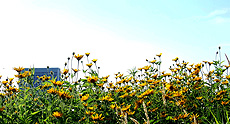 |
| Wilson Hall hides behind a bed of flowers. Photo: Alyssa Miller |
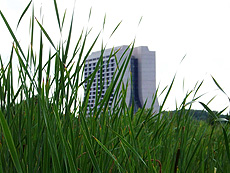 |
| It's seen from a field of grass in the Main Ring. Photo: Alyssa Miller |
|
Neighbors mostly curious about physics experiment at Fermilab
From Chicago Tribune, June 25, 2015
An upcoming, billion-dollar international physics experiment might cause increased noise and traffic in the areas bordering Batavia-based Fermilab, but most residents don't seem too concerned.
The majority of about 80 residents who attended a U.S. Department of Energy public forum Wednesday at Fermilab were there, rather, out of pure fascination with the scope of the experiment.
"Just the whole concept of neutrinos moving underground to South Dakota, it's mind-boggling," said John Talbot, a Batavia resident who lives near the laboratory. "There will be construction, of course, but this is different. If this helps sustain Fermilab, it's a good thing."
Read more
|
|
Summer heat
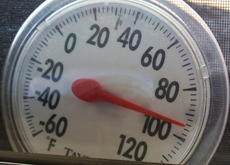 |
| Summer is here, and temperatures will continue to climb. Take reasonable precautions against the heat. Photo: Mr.TinDC |
Both indoor and outdoor workers can be at risk for heat stress, and humidity compounds the risk. It increases the heat index and the probability of sunstroke, heat cramps, heat exhaustion and fatigue. Extreme heat can cause illness and death as well.
To avoid heat stress over the summer:
- Drink plenty of water.
- Wear light, loose-fitting, breathable clothing.
- Take frequent short breaks in air conditioning or cool shade.
- Eat smaller meals before outdoor activity.
- Avoid caffeine, alcohol and large amounts of sugar.
- Be aware that some health conditions and medications can increase your susceptibility to heat stress.
- Be aware that some kinds of protective equipment such as respirators or work suits can increase heat stress.
Sometimes even with the best precautions, the heat can overwhelm you. Watch for clammy, moist skin, heavy sweating, extreme weakness or fatigue, headache, nausea, dizziness, muscle cramps, or flushed or pale complexion. Heat exhaustion victims should drink plenty of water and seek medical attention. During normal work hours, on-site victims should report to the Medical Office. Off hours, they should go to the Fire Department or call x3131.
Heat stroke causes hot, dry skin or profuse sweating, throbbing headache, unconsciousness, convulsions and vomiting. This condition is a medical emergency. If a heat stroke occurs off site, call 911. If a heat stroke occurs on site, call x3131. Cool the victim quickly with cooling water, fanning, and remove to a cool, shaded area.
—Caroline Hetfield, ANP-BC
|
Science Next Door July newsletter now online
The July edition of Science Next Door, Fermilab's monthly community newsletter, is now available online. View it or subscribe to get the latest about the laboratory's public events, including tours, lectures, arts events and volunteer opportunities.
|
New employees - June
The following regular employees started at Fermilab in June:
Sebastien Aderhold, TD; Dave Bigelow, TD; Justin Carmichael, TD; Yesenia Govea-Vargas, AD; Alexander Himmel, ND; Alyssa Miller, AD; Sandra Nelson, FS; Charles Orozco, TD; Vincent Roger, TD; Carlo Santini, TD; Dawn Staszak, IARC; Nadja Strobbe, PPD; Paul Tader, SCD; Christopher Toman, AD; Hannah Ward, CCD; Mohammed Yahya, CCD; Ian Young, PPD.
Fermilab welcomes them to the laboratory.
|
Relativity's time dilation may limit the quantum world
From ars technica, June 26, 2015
A new theoretical paper has tackled the phenomenon of quantum decoherence, the process by which objects slip out of the quantum world and start behaving classically. The paper approaches this in a new way by applying an effect of general relativity to decoherence. The paper claims that gravity is the key to the disparity between the weird quantum world and the everyday, familiar world of human-sized objects in which we live.
Decoherence is a concept central to quantum mechanics. Essentially, a quantum particle, unlike a macroscopic object, can exist in a superposition of different states. This means that in a real, physical way, it exists in all those different states at the same time (with varying probabilities; the stronger the probability of a state, the more strongly the particle inhabits that state).
Read more
|
|